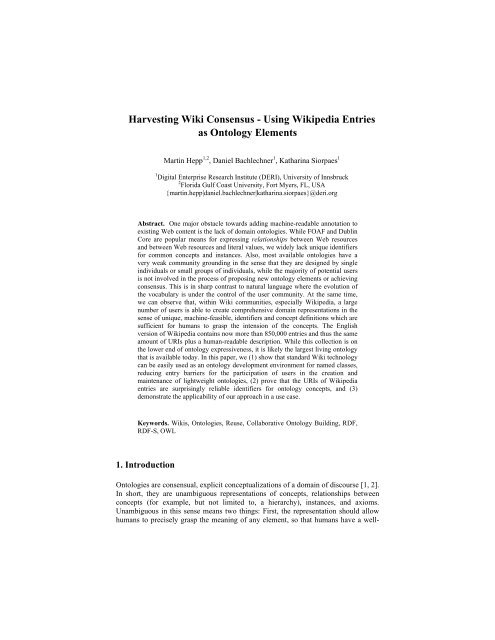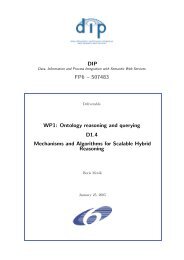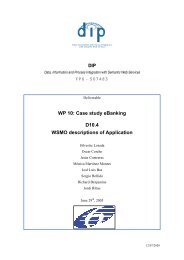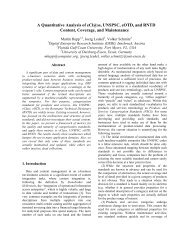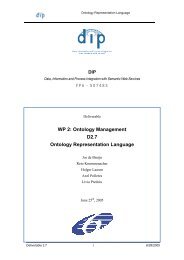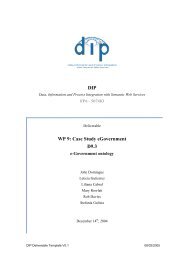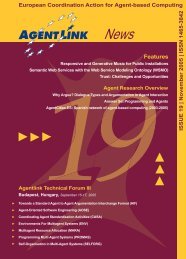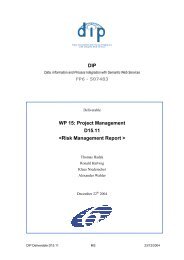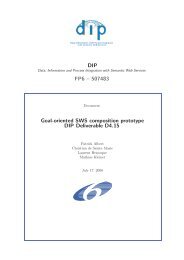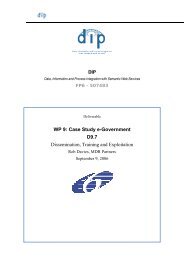Using Wikipedia Entries as Ontology Elements - CiteSeerX
Using Wikipedia Entries as Ontology Elements - CiteSeerX
Using Wikipedia Entries as Ontology Elements - CiteSeerX
Create successful ePaper yourself
Turn your PDF publications into a flip-book with our unique Google optimized e-Paper software.
Harvesting Wiki Consensus - <strong>Using</strong> <strong>Wikipedia</strong> <strong>Entries</strong><strong>as</strong> <strong>Ontology</strong> <strong>Elements</strong>Martin Hepp 1,2 , Daniel Bachlechner 1 , Katharina Siorpaes 11 Digital Enterprise Research Institute (DERI), University of Innsbruck2 Florida Gulf Co<strong>as</strong>t University, Fort Myers, FL, USA{martin.hepp|daniel.bachlechner|katharina.siorpaes}@deri.orgAbstract. One major obstacle towards adding machine-readable annotation toexisting Web content is the lack of domain ontologies. While FOAF and DublinCore are popular means for expressing relationships between Web resourcesand between Web resources and literal values, we widely lack unique identifiersfor common concepts and instances. Also, most available ontologies have avery weak community grounding in the sense that they are designed by singleindividuals or small groups of individuals, while the majority of potential usersis not involved in the process of proposing new ontology elements or achievingconsensus. This is in sharp contr<strong>as</strong>t to natural language where the evolution ofthe vocabulary is under the control of the user community. At the same time,we can observe that, within Wiki communities, especially <strong>Wikipedia</strong>, a largenumber of users is able to create comprehensive domain representations in thesense of unique, machine-fe<strong>as</strong>ible, identifiers and concept definitions which aresufficient for humans to gr<strong>as</strong>p the intension of the concepts. The Englishversion of <strong>Wikipedia</strong> contains now more than 850,000 entries and thus the sameamount of URIs plus a human-readable description. While this collection is onthe lower end of ontology expressiveness, it is likely the largest living ontologythat is available today. In this paper, we (1) show that standard Wiki technologycan be e<strong>as</strong>ily used <strong>as</strong> an ontology development environment for named cl<strong>as</strong>ses,reducing entry barriers for the participation of users in the creation andmaintenance of lightweight ontologies, (2) prove that the URIs of <strong>Wikipedia</strong>entries are surprisingly reliable identifiers for ontology concepts, and (3)demonstrate the applicability of our approach in a use c<strong>as</strong>e.Keywords. Wikis, Ontologies, Reuse, Collaborative <strong>Ontology</strong> Building, RDF,RDF-S, OWL1. IntroductionOntologies are consensual, explicit conceptualizations of a domain of discourse [1, 2].In short, they are unambiguous representations of concepts, relationships betweenconcepts (for example, but not limited to, a hierarchy), instances, and axioms.Unambiguous in this sense means two things: First, the representation should allowhumans to precisely gr<strong>as</strong>p the meaning of any element, so that humans have a well-
4 Martin Hepp, Daniel Bachlechner, Katharina Siorpaeswe analyzed whether the concept represented by the URI at the time of adding thisentry is still consistent with the most recent description retrievable at the respectiveURI, i.e. whether annotations made using the URI in the p<strong>as</strong>t remain correct despitethe fact that Wiki entries can be e<strong>as</strong>ily modified by an open community. Weespecially analyzed the amount of disambiguation pages, which are inserted when thesame terminology refers to distinct concepts in various contexts. Fourth, wequantitatively analyzed properties like average age of entries and amount of changeper time. Since we know from statistics that random samples are, if designedproperly, very reliable estimates for the full population (i.e. the full <strong>Wikipedia</strong>content), our approach returns precise data about the suitability of <strong>Wikipedia</strong> content<strong>as</strong> concepts.1.3 Related WorkWork related to ours mainly falls into the following categories:Community-driven <strong>Ontology</strong> Building: There is already significant literature aboutcollaborative ontology engineering in general, e.g. Tadzebao and WebOnto (see [7]).[8] describe collaborative ontology building in analogy to Wikis, but (1) do notborrow more from the Wiki community than the pure name, (2) take a very richontology meta-model <strong>as</strong> the starting point, (3) do not elaborate on the communityfocus of ontology building, and (4) do not address the advantage of addingmultimedia elements in the informal descriptions of concepts.Wikispecies [9] can already be regarded <strong>as</strong> a first Wiki-centric ontology for species. Iteven includes a subsumption hierarchy; which is, however, a lesser challenge in thisnarrow application domain since there is a single consensual taxonomy in Biology,the Linnaean taxonomy. Recently, the term “Folksonomies” w<strong>as</strong> brought up <strong>as</strong> areference for on the fly cl<strong>as</strong>sifications created by users [10, 11]. This work is verymuch related to ours, however there are main differences. First, we aim at reusing thev<strong>as</strong>t amount of existing <strong>Wikipedia</strong> entries <strong>as</strong> ontology elements. Second, we do notdistinguish between tags and <strong>Wikipedia</strong> pages, i.e. we propose to use each <strong>Wikipedia</strong>URI <strong>as</strong> the identifier for a concept. Third, we point to the importance of multimediaelements in <strong>Wikipedia</strong> entries for capturing the intension of such concepts. Fourth, westress the fact that the history function of <strong>Wikipedia</strong> is an important component of aconcept definition, since it reflects the discourse that h<strong>as</strong> led to the most recent state.[12] points out that the entry barriers for ontology development and usage should belowered. The “Simple Knowledge Organisation System (SKOS)” [13] is such anapproach. [14] describes the DILIGENT knowledge processes which proposesontology evolution and collaborative concept mapping and refinement <strong>as</strong> coretechniques for building ontologies in order to deal better with domain dynamics andother ontology engineering challenges.Augmenting Wikis with Semantic Web technology: Platypus Wiki [15] is a Wikiaugmented by Semantic Web approaches, namely RDF, while we want to use Wikisfor creating ontologies that can be used anywhere in the Semantic Web. [16]describes Rhizome, a Semantic Wiki system that also includes the functionality of
Harvesting Wiki Consensus - <strong>Using</strong> <strong>Wikipedia</strong> <strong>Entries</strong> <strong>as</strong> <strong>Ontology</strong> <strong>Elements</strong> 5creating arbitrary RDF resources e<strong>as</strong>ily. A first version of our work h<strong>as</strong> beenpresented in [17], but this prototype aimed at deploying a modified Wiki installation<strong>as</strong> an ontology engineering platform, while we now think that <strong>Wikipedia</strong> must be thestarting point due to the enormous number of existing entries and community pickup.At a non-ontology level, the usefulness of <strong>Wikipedia</strong> <strong>as</strong> a point of reference isdiscussed in [18]; however, this refers more to the <strong>as</strong>pect whether all facts said abouta topic are authoritative in detail, and not whether the URIs represent consensualconcepts.Especially in the l<strong>as</strong>t months, there is v<strong>as</strong>t interest in combining Semantic Weband Wiki approaches. However, all approaches known to us are different to ours inthe Way that they aim at augmenting Wikis with Semantic Web components, whilewe propose (1) to use unmodified Wikis <strong>as</strong> a platform for collaborative ontologybuilding on the level of named cl<strong>as</strong>ses, and (2) harvest the wealth of conceptdefinitions already contained in <strong>Wikipedia</strong>. In this sense, our work is complimentaryto “Semantic Web Wiki” work and can be e<strong>as</strong>ily combined with such approaches.2. Understanding <strong>Wikipedia</strong> <strong>as</strong> an <strong>Ontology</strong> Asset and <strong>Ontology</strong> Workbench forthe M<strong>as</strong>sesWe propose to use Wiki implementations in general and especially <strong>Wikipedia</strong> <strong>as</strong> ameans for(1) defining URIs for concepts,(2) describing the intension of those concepts in natural language, and probablyaugmented by multimedia elements, e.g. drawings, pictures, videos, or soundrecordings, and(3) preserving the discourse that h<strong>as</strong> led to the current version of a Wiki page <strong>as</strong> animportant part of the definition of the respective URI.In a nutshell, we understand the URIs of Wiki/<strong>Wikipedia</strong> entries <strong>as</strong> identifiers fornamed cl<strong>as</strong>ses. This approach appears very straightforward and might even beperceived trivial. However, it is trivial only on the technological level, but should bequantitatively validated prior to its usage.The motivation for this approach is b<strong>as</strong>ed on the following <strong>as</strong>pects:(1) <strong>Wikipedia</strong> contains more than 850,000 entries and is likely the biggestcollection of URIs augmented by a textual definition available.(2) <strong>Wikipedia</strong> is popular <strong>as</strong> a reference and its concepts can thus be expected tohave commitment by a wide audience. B<strong>as</strong>ed on our analysis given below,we can estimate that the total amount of active contributions (e.g. additionsor modifications) exceeds 2,465,000 per month. More than 50 % of theconcepts have been changed at le<strong>as</strong>t once per each month of their existence.(3) Wiki technology imposes only minimal requirements on a user and is likelythe simplest way of creating a persistent URI plus informal description.Anybody can add a URI for a needed concept anytime.(4) Most Wiki packages contain a comprehensive history function that allowsreferring to both the latest version <strong>as</strong> well <strong>as</strong> each p<strong>as</strong>t version of an entry
6 Martin Hepp, Daniel Bachlechner, Katharina Siorpaesusing unique URIs. Thus, different states of the discourse become FirstOrder Objects (FOOs) that can also be referred to.The main paradigm of our work is simplicity, i.e. we want to support only <strong>as</strong> muchfunctionality <strong>as</strong> can be used productively by a large share of the community.2.1. Research ChallengesWhen using Wiki entries <strong>as</strong> ontology elements, we see at le<strong>as</strong>t the following researchchallenges.Resource vs. Concept: One can argue whether the URIhttp://en.wikipedia.org/wiki/Let_it_berefers to this specific <strong>Wikipedia</strong> entry <strong>as</strong> a resource or to the respective album by theBeatles. We propose <strong>as</strong> a minimal ontological commitment to our approach that each<strong>Wikipedia</strong> entry is to be understood <strong>as</strong> the entity that an average layman <strong>as</strong>sociateswith this description. In this sense, the URI quite naturally reflects the Beatles album,not the <strong>Wikipedia</strong> description of the album. This is a proposed social convention andcan of course be debated, but makes a lot of sense in the context of our proposal.Wiki <strong>Entries</strong>: Cl<strong>as</strong>ses or Instances: Since there is no explicit knowledgerepresentation model in the background, a Wiki entry can be anything; it is not clearwhether it refers to an instance, a concept, or a property. By social convention,<strong>Wikipedia</strong> contains mostly entries that are proper nouns and does not includerelationships and properties (see also below). So it must be clarified whether a Wikientry is to be treated <strong>as</strong> a cl<strong>as</strong>s or <strong>as</strong> an instance, at le<strong>as</strong>t if the ontology modelrequires a choice between these two. We solve this issue by omitting this distinctionbetween instance and cl<strong>as</strong>s, which is no significant problem in pure RDF or in OWLFull.Versioning and Wiki URI Schemes: A standard Wiki already provides allfunctionality necessary to create a textual definition and a unique URI. For example,anybody could have added an entry for the Republic of Austria to <strong>Wikipedia</strong>, nowavailable athttp://en.wikipedia.org/wiki/Austria.We could immediately use this mechanism and propose to re-use this URI not only <strong>as</strong>the resource locator for retrieval of the description, but also <strong>as</strong> the identifier for theconcept “Republic of Austria”. Now the problem is that since everybody can alter thetext, we never know whether the current version is a monotonic extension of anyprevious version. So anybody who used this URI for the annotation of instances orany other statement might find that his statement no longer holds with the modifiedversion. We propose a very hands-on solution, b<strong>as</strong>ed on a combination of the“history” functionality in the MediaWiki distribution, and a versioning schemeembedded in the URI for concepts, same <strong>as</strong> used by the W3C for W3C documents or
Harvesting Wiki Consensus - <strong>Using</strong> <strong>Wikipedia</strong> <strong>Entries</strong> <strong>as</strong> <strong>Ontology</strong> <strong>Elements</strong> 7the WSMO, WSMX, and WSML working groups [19]. The main idea is that thegeneral URI, e.g.http://en.wikipedia.org/wiki/Austriaalways refers to the latest version, while all intermediate versions have an additionalURI of their own.In MediaWiki/<strong>Wikipedia</strong>, all intermediate versions already have unique identifiers inthe following form:http://en.wikipedia.org/w/index.php?title=Austria&oldid=23005009However, since this includes the name of the script “index.php”, it is not fullycompliant with the design principles of URIs, see [20].It would be desirable if the MediaWiki software is modified in a sense that makes thehistory entries use persistent URIs that are not bound to implementation details (e.g.PHP). This could be achieved e.g. by adding the date and time of creation (plusprobably the IP address of the originator):http://en.wikipedia.org/wiki/Austria/YYYY-MM-DD-HH-MM-SS-IPThis allows to refer either to the latest version or to any specific version. It also makesit possible to create statements about a specific version. This challenge is closelyrelated to the next one.Conceptual Consistency of URIs over time: Wiki entries can be modified andchanged by anyone and there are no substantial institutional agreements between theusers who create a new entry and the ones who modify it later. It is possible that theconcept represented by a URI changes substantially over time, rendering oldannotations inconsistent. This is especially a problem when so called “disambiguationpages” are introduced, which happens when the community realizes that the sameword is a homonym and used in very different senses in different contexts. In suchc<strong>as</strong>es, the original page is turned into a disambiguation page that contains separatelinks to the multiple context-specific entries. A core part of our work presented in thispaper deals with a quantitative analysis of this problem, i.e. whether this theoreticalproblem is a significant obstacle, or whether it is negligible.Dominance of Proper Nouns: While Wiki packages alone can also be used to defineURIs for properties, e.g.http://en.wikipedia.org/wiki/isAFriendOf,it is by social convention that <strong>Wikipedia</strong> does not contain such entries. This meansthat we cannot find properties and relationships <strong>as</strong> entries in <strong>Wikipedia</strong>. There are atle<strong>as</strong>t three ways of dealing with this:(1) We use properties and relationships defined in popular existing ontologies,namely Dublin Core elements [21, 22] together with <strong>Wikipedia</strong> entries.(2) We create complimentary property ontologies in an engineering f<strong>as</strong>hion, e.g.“sells”, “rents”, “repairs” for e-Commerce applications.(3) We modify Wiki packages so that they can be used for defining objectproperties (linking resources <strong>as</strong> subjects to <strong>Wikipedia</strong> entries <strong>as</strong> objects) and
8 Martin Hepp, Daniel Bachlechner, Katharina Siorpaesdatatype properties (linking resources to literal values) and deploy acomplimentary “Property <strong>Wikipedia</strong>”.All three approaches can be used in combination. We have already implementedthe second and third approach. For re<strong>as</strong>ons of simplicity, we restrict the example inthis paper to the use of Dublin Core elements, though.Redundancy: In collaborative ontology engineering, it can happen e<strong>as</strong>ily thatmultiple entries for the same concept are created. This h<strong>as</strong> no negative impact onprecision, but lowers the recall of information retrieval. Wiki contains mechanismsfor merging pages in such c<strong>as</strong>es. In this c<strong>as</strong>e, “#redirect [[PAGENAME]]” is to beinserted into the body of the discontinued page. Such links could be translated intostatements of equivalence.Selection of a Proper <strong>Ontology</strong> Meta-Model: We have to define an ontology metamodelthat is suitable for a large audience. In our current approach, we support onlyplain RDF and completely leave out any kind of hierarchical order. This is notbecause we think this would be irrelevant; we are rather still researching propersupport mechanisms that help yield consensual subsumption hierarchies. The problemwith collaborative building of subsumption hierarchies is that a local modification canhave lots of unwanted side effects that are not immediately obvious.2.2 ExampleIn the following, we give an example of how <strong>Wikipedia</strong> entries can be used fordescribing Web resources. The example is b<strong>as</strong>ed on the social convention that thereused <strong>Wikipedia</strong> entries are understood <strong>as</strong> the entity or concept that an averagelayman <strong>as</strong>sociates with this description, not <strong>as</strong> the Web resource itself. In this sense,http://en.wikipedia.org/wiki/John_Lennonrefers to John Lennon <strong>as</strong> the singer an not to the <strong>Wikipedia</strong> entry about John Lennon.The example below represents the facts that- John Lennon w<strong>as</strong> a contributor to the Beatles album “Let It Be”,- the title of this Beatles album is “Let It Be (Beatles Album)”,- John Lennon is related to John Lennon’s discography andthat John Lennon can be described by “John Winston Ono Lennon w<strong>as</strong> a singer,songwriter, poet and guitarist for the British rock band The Beatles”.
Harvesting Wiki Consensus - <strong>Using</strong> <strong>Wikipedia</strong> <strong>Entries</strong> <strong>as</strong> <strong>Ontology</strong> <strong>Elements</strong> 9Let It Be (Beatles Album) John Winston Ono Lennon w<strong>as</strong> a singer, songwriter,poet and guitarist for the British rock band TheBeatles.Figure 1 shows the resulting RDF graph.Figure 1. The resulting RDF graph.3. EvaluationIn this section, we provide evidence that our approach is not only possible from atechnical standpoint, but that the URIs of <strong>Wikipedia</strong> entries are surprisingly reliableidentifiers for ontology concepts, despite the fact that they are yielded in acommunity-driven manner.3.1 MethodologyWe want to test whether the concepts defined by the URIs of <strong>Wikipedia</strong> entriesundergo significant change during their lifespan, or whether modifications tend just toadd more information, which would not change the intension of the concept, but justallow additional inferences.For this purpose, we took a random sample (n=100) of entries in the English versionof WikiPedia on November 17, 2005. For this purpose, we used the „random page“functionality of the MediaWiki software. We <strong>as</strong>sume that the random numbergenerator employed is of sufficient quality for the purpose of this experiment. We
10 Martin Hepp, Daniel Bachlechner, Katharina Siorpaesknow from statistics that the mean and median of a sample is a reliable estimate forthe mean and median of the full population, which frees us from the need to analyseall 850,000 entries in <strong>Wikipedia</strong>.For each of the selected <strong>Wikipedia</strong> URIs, we performed the following two t<strong>as</strong>ks:(1) We compared whether the concept or entity identified by the URI h<strong>as</strong>changed significantly between the very first version and the current versions,in the sense that a layman annotation of a Web resource or a laymanstatement about the initial concept would hold for the first version but not forthe current or vice versa. We distinguished the following c<strong>as</strong>es:C<strong>as</strong>e 1a: No significant change in meaning; the entry h<strong>as</strong> been a stable,regular concept from its very first version to the current one.C<strong>as</strong>e 1b: The entry h<strong>as</strong> always been a Wiki “disambiguation page”. It refersto a stable concept (i.e. all homonyms that could be referred to by this name).C<strong>as</strong>e 2: A minor change in meaning h<strong>as</strong> occurred. An example is that“Gloucester Courthouse” initially referred to the town and now refers to the“census designated place”, which is still the same for many purposes.C<strong>as</strong>e 3a: There w<strong>as</strong> a major change in meaning.C<strong>as</strong>e 3b: The URI w<strong>as</strong> a regular entry in the beginning but turned into adisambiguation page later.(2) For each entry, we also recorded the time and date of creation, the time anddate of the l<strong>as</strong>t modification, the amount of editing t<strong>as</strong>ks over its lifespan andper month of existence, and its age, i.e. the time lapsed between the initialcreation and the date of our experiment (November 17, 2005).Our hypothesis is that despite the ongoing change and uncontrolled editing of<strong>Wikipedia</strong> entries, there exists a stable community consensus about the meaning ofthe respective URI.3.3 ResultsIn the following, we summarize the results of our experiment. Table 1 shows that only3 % of the sample have turned into a disambiguation page during its lifespan. This isinsofar important at this category of entry can have the most negative impact onprecision in the usage of concepts for information retrieval, since initially, twocommunities might use the same URI to refer to distinct concepts.
12 Martin Hepp, Daniel Bachlechner, Katharina SiorpaesTable 3. Distribution properties of the number of modifications per <strong>Wikipedia</strong> URINumber of modifications per <strong>Wikipedia</strong> URIAbsolute numberModifications permonth of existenceMean 21.8 2.9Median 9.5 1.2Variance 1,408.5 50.4StandardDeviation 37.5 7.1Q1 5.0 0.6Q2 9.5 1.2Q3 19.0 2.7Q4 233.0 66.6Table 4 indicates the distribution of the age of entries in days. 50 % of the entrieswere created less than 363 days before November 17, 2005. This is an amazingindication of how <strong>Wikipedia</strong> h<strong>as</strong> gained interest and user involvement. 75 % (see thethird quartile, Q3) were created less than 610 days before November 17, 2005, andonly 25 % of the entries have been created more than 609 days ago.Table 4. Lifespan in days (from creation until Nov 17, 2005)Lifespan in days(from creation until Nov 17, 2005)Mean 412,6Median 362,7Variance 121697,3Standard Deviation 348,9Q1 102,7Q2 362,7Q3 609,0Q4 1360,74. DiscussionThe data from our experiment shows quite clearly that for the v<strong>as</strong>t majority of<strong>Wikipedia</strong> entries, there is community consensus about the meaning of the URI fromthe very beginning to the most recent version. In other words, communities seem tobe able to achieve consensus about named cl<strong>as</strong>ses <strong>as</strong> very lightweight ontological
Harvesting Wiki Consensus - <strong>Using</strong> <strong>Wikipedia</strong> <strong>Entries</strong> <strong>as</strong> <strong>Ontology</strong> <strong>Elements</strong> 13agreements in an unsupervised f<strong>as</strong>hion and with only the known mechanisms forpreventing destructive changes of standard Wiki software.As shown above, we can estimate that each month, about 2,465,000 changeoperations are made by <strong>Wikipedia</strong> users, but only 5 % of concepts change in a majorsense during their lifespan. We think this is a fundamental argument in favor ofcommunity-centric ontology building.Also, our findings show that the majority of work on <strong>Wikipedia</strong> h<strong>as</strong> been done in thel<strong>as</strong>t 20 months, since 75 % of the content of the English <strong>Wikipedia</strong> h<strong>as</strong> been added inthat timeframe.Of course, there are drawbacks. First of all, what we can reuse from <strong>Wikipedia</strong> <strong>as</strong>ontology components are just named cl<strong>as</strong>ses. There is zero support for re<strong>as</strong>oningt<strong>as</strong>ks. By intention, we did not try to include any subsumption hierarchy or axioms.The re<strong>as</strong>on is that other preliminary experiments which we carried out show that onlyvery simple ontology metamodels are suitable for collaborative ontology building. Wesuspect that two major re<strong>as</strong>ons are the prohibitive “cost” of learning complexontology models and the lack of transparency of effects for the average user. A simplenon-consensual rdfs:subCl<strong>as</strong>sOf statement can render the annotations of amultiplicity of users incorrect, and a simple modification of rdf:domain can leadto cl<strong>as</strong>s memberships that are not intended. Our future research will focus on how thisskeleton can be extended towards a richer ontology meta-model without introducingnew entrance barriers for users. We think for example of clever voting mechanismswith thresholds that make a subsumption relationship subject to community voting.Also, 5% of concepts that change their meaning over time means that someannotations will become corrupt over time. However, we regard this <strong>as</strong> a trade-offdecision between ontology coverage in the sense of timely addition of neededconcepts, and consistency. We think that we cannot prevent the Semantic Web tobreak here and then. It is important to recall that a core catalyst to the success of theWeb w<strong>as</strong> the willingness to accept inconsistencies and broken links in return foragility and distributed evolution.In our opinion, the delegation of ontology building to a small “elite” group ofontology engineers is conceptually flawed, since the small group h<strong>as</strong> no immediateaccess to the representational requirements and the conceptuzational preferences ofthe community members.5. ConclusionWe have shown that standard Wiki technology can be e<strong>as</strong>ily used <strong>as</strong> an ontologydevelopment environment without modification, reducing entry barriers for theparticipation of users in the creation and maintenance of lightweight ontologies. Onthe b<strong>as</strong>is of a quantitative analysis of current <strong>Wikipedia</strong> entries and their propertieswe have provided substantial evidence that the URIs of <strong>Wikipedia</strong> entries aresurprisingly reliable identifiers for ontology concepts. In addition, we havedemonstrated how the 850,000 entries in <strong>Wikipedia</strong> can be used <strong>as</strong> ontology elements,opening this enormous source of named cl<strong>as</strong>ses for making the Semantic Web areality.
14 Martin Hepp, Daniel Bachlechner, Katharina SiorpaesAcknowledgements: The work presented in this paper is partly funded by theEuropean Commission under the project DIP (FP6-507483), the TransITEntwicklungs- und Transfercenter at the University of Innsbruck, and Florida GulfCo<strong>as</strong>t University.References[1] N. Guarino, "Formal <strong>Ontology</strong> and Information Systems," presented at FOIS '98,Trento, Italy, 1998.[2] T. R. Gruber, "Toward principles for the design of ontologies used for knowledgesharing," International Journal of Human-Computer Studies, vol. 43, pp. 907-928,1995.[3] D. Fensel, Ontologies: A Silver Bullet for Knowledge Management and ElectronicCommerce, 2nd ed. Berlin etc.: Springer, 2004.[4] W3C, "OWL Web <strong>Ontology</strong> Language Guide. W3C Recommendation 10 February2004," available at http://www.w3.org/TR/2004/REC-owl-guide-20040210/,retrieved Nov 30, 2005.[5] M. Hepp, "A Methodology for Deriving OWL Ontologies from Products andServices Categorization Standards," presented at 13th European Conference onInformation Systems (ECIS2005), Regensburg, Germany, 2005.[6] M. Hepp, "Representing the Hierarchy of Industrial Taxonomies in OWL: Thegen/tax Approach," presented at ISWC Workshop Semantic Web C<strong>as</strong>e Studies andBest Practices for eBusiness (SWCASE05), Galway, Irland, 2005.[7] J. Domingue, "Tadzebao and WebOnto: Discussing, Browsing, and EditingOntologies on the Web," presented at 11th Knowledge Acquisition for Knowledge-B<strong>as</strong>ed Systems Workshop, Banff, Canada, 1998.[8] J. Bao and V. Honavar, "Collaborative <strong>Ontology</strong> Building with Wiki@nt. A multiagentb<strong>as</strong>ed ontology building environment," presented at 3rd InternationalWorkshop on Evaluation of <strong>Ontology</strong>-b<strong>as</strong>ed Tools (EON2004), Hiroshima, Japan,2004.[9] Wikimedia Foundation, "Wikispecies," available at http://species.wikipedia.org/,retrieved Nov 30, 2005.[10] <strong>Wikipedia</strong>, "Folksonomy," available at http://en.wikipedia.org/wiki/Folksonomy,retrieved Nov 30, 2005.[11] A. Mathes, "Folksonomies -Cooperative Cl<strong>as</strong>sification and Communication ThroughShared Metadata," available at http://www.adammathes.com/academic/computermediated-communication/folksonomies.html,retrieved Nov 30, 2005.[12] M. D. Lytr<strong>as</strong>, "Semantic web and information systems: An agenda b<strong>as</strong>ed ondiscourse with community leaders," International Journal of Semantic Web andInformation Systems, vol. 1, pp. i-xii, 2005.[13] W3C, "Simple Knowledge Organisation System (SKOS)," available athttp://www.w3.org/2004/02/skos/, retrieved Nov 30, 2005.[14] D. Vrandecic, S. Pinto, C. Tempich, and Y. Sure, "The DILIGENT knowledgeprocess," Journal of Knowledge Management, vol. 9, pp. 85-96, 2005.[15] S. E. Campanini, P. C<strong>as</strong>tagna, and R. Tazzoli, "Platypus Wiki: a Semantic Wiki WikiWeb," presented at 1st Italian Semantic Web Workshop Semantic Web Applicationsand Perspectives (SWAP), Ancona, Italy, 2004.[16] A. Souzis, "Building a Semantic Wiki," IEEE Intelligent Systems, vol. 20, pp. 87-91,2005.
Harvesting Wiki Consensus - <strong>Using</strong> <strong>Wikipedia</strong> <strong>Entries</strong> <strong>as</strong> <strong>Ontology</strong> <strong>Elements</strong> 15[17] M. Hepp, D. Bachlechner, and K. Siorpaes, "OntoWiki: Community-driven <strong>Ontology</strong>Engineering and <strong>Ontology</strong> Usage b<strong>as</strong>ed on Wikis," presented at Proceedings of the2005 International Symposium on Wikis (WikiSym 2005), San Diego, California,USA, 2005.[18] <strong>Wikipedia</strong>, "Criticism of <strong>Wikipedia</strong>," available athttp://en.wikipedia.org/wiki/Criticism_of_<strong>Wikipedia</strong>, retrieved Nov 30, 2005.[19] J. de Bruijn and J. Kopecký, "Persistent URIs for WSMO and WSML deliverables.WSMO Note 2 February 2005," available at http://www.wsmo.org/TR/NOTE-URIs/20050202/, retrieved Nov 30, 2005.[20] T. Berners-Lee, "Cool URIs don't change," available athttp://www.w3.org/Provider/Style/URI.html, retrieved Nov 8, 2004.[21] Dublin Core Metadata Initiative, "Dublin Core Metadata Element Set, Version 1.1:Reference Description," available at http://dublincore.org/documents/dces/, retrievedNov 30, 2005.[22] Dublin Core Metadata Initiative, "DCMI Metadata Terms," available athttp://dublincore.org/documents/dcmi-terms/, retrieved Nov 30, 2005.


